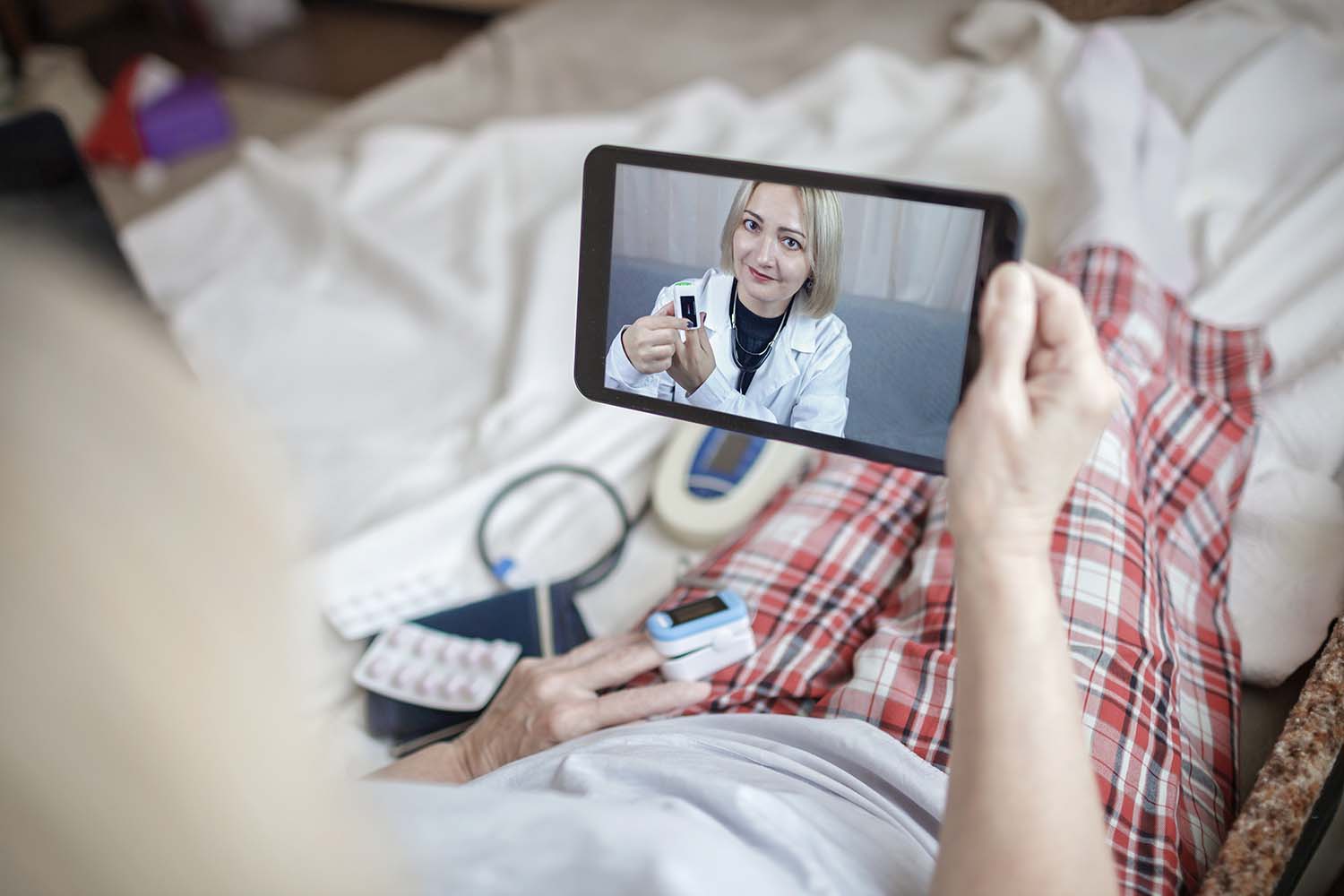BONNIE BRAASCH HAS FACED two major medical challenges in the past six years. The first was her stage I breast cancer diagnosis in November 2015, which led to a lumpectomy followed by radiation therapy. The second challenge was in June 2020 during the coronavirus pandemic. “I had COVID,” Braasch says. “My husband did too.”
While they had the coronavirus, Braasch and her husband, who live in Rochester, Minnesota, both enrolled in a remote patient monitoring program at the Mayo Clinic that was originally conceived as a way to monitor the vital signs and symptoms of cancer patients who were at risk for serious complications. As the coronavirus hit the U.S., the Mayo Clinic, which is also located in Rochester, adapted this “hospital at home” technology to monitor people with COVID-19 to keep hospital beds open for the patients with the most critical needs. “We wanted to safely handle as many COVID-19 cases as possible outside our hospital,” says Tufia Haddad, a breast cancer oncologist and medical director for remote patient monitoring with the Mayo Clinic’s Center for Digital Health.
Other hospitals employed similar approaches, and research is spotlighting the benefits of remote care for cancer patients who also had COVID-19. A study published June 4, 2021, in JCO Oncology Practice looked at the effects of remote monitoring on patients with COVID-19 who were receiving cancer treatment or whose cancer was recently in remission. Of 187 patients, the risk of hospitalization for patients who had remote monitoring was 2.8%, while the risk of hospitalization for those who did not have remote monitoring was 13%. That difference in hospitalization rates equated to a 76% relative risk reduction for hospitalization, notes Haddad, who was an author of the study.
Another study published in the same issue of JCO Oncology Practice reported survey results from 257 cancer patients who had COVID-19 and participated in a remote monitoring program at Memorial Sloan Kettering Cancer Center in New York City. Patients answered questions about their symptoms, such as difficulty breathing and diarrhea, and were also sent home with a pulse oximeter, which provided data about patients’ blood oxygen levels and heart rates. Eighty-seven percent of patients agreed that their participation in the program was an important part of their care.
While enrolled in the Mayo Clinic remote monitoring program, Braasch and her husband used tools to measure their blood pressure, blood oxygen, heart rate and temperature two or three times a day at home. If the clinical team noted a change in their vitals, the care team would reach out to check on them. That’s what happened one morning when Braasch’s blood pressure dropped. “I got a phone call within 20 minutes of that information being received,” she says. “They wanted to know if I was all right.” They directed her to take her blood pressure again and confirmed she was OK. Haddad notes that patients with COVID-19 can experience drops in oxygen saturation levels before they experience a worsening of symptoms. “We are able to then intervene, potentially without the need to bring them into the hospital,” she says.
The Memorial Sloan Kettering program worked similarly, according to Bobby Daly, a medical oncologist and health service researcher. With regular, proactive assessments of patient symptoms via remote monitoring at Memorial Sloan Kettering, Daly and other physicians could provide earlier intervention to head off more serious problems. For example, when one of Daly’s cancer patients with COVID-19 went home after hospitalization with pneumonia, only to experience a drop in blood oxygen level, Daly was able to order supplemental oxygen for that patient at home. “In a prior scenario,” he says, “it would have required either an emergency room visit or a clinic visit.”
In addition, other research suggests remote monitoring could increase survival rates for people with cancer, making it another tool in the oncologist’s toolbox. For example, data published in JAMA in 2019 suggests web-based symptom monitoring, when added to routine scans and follow-up visits, increased two-year survival in lung cancer patients who completed treatment compared to those patients who did not participate in remote symptom monitoring. “Think about all the money we spend on drugs and medications to try and improve survival in our cancer patients,” Haddad says. “Here was this really simple intervention where we are just monitoring symptoms.”
Both Mayo Clinic and Memorial Sloan Kettering were already exploring the use of remote patient monitoring programs for cancer patients before the COVID-19 pandemic and will continue to offer the programs. In fact, research published Oct. 1, 2020 in JCO Oncology Practice on the pilot program at Memorial Sloan Kettering, which allowed patients to fill out daily assessments to report symptoms—even without the tools to monitor vital signs—showed a 17% reduction in reduced emergency department visits compared to patients who were not enrolled in the program. Patients and physicians who participated in the pilot also perceived value in the program, Daly says.
Mayo Clinic was on the cusp of launching a remote monitoring program for cancer patients who were receiving stem cell transplants or CAR-T cell therapy when the COVID-19 pandemic forced the hospital to change plans. As the facility winds down the COVID-19 patient monitoring program, the next steps will involve pilots assessing new technologies, such as wearable armbands, that could collect more in-depth and continuous data remotely, Haddad says.
Braasch says she is already convinced of the value of remote patient monitoring programs and wishes something similar had been available to her during her breast cancer treatment. “It’s just a wonderful thing for the cancer journey,” she says. “By having that connection, it’s helpful for both ends—the medical team and the patient. A lot of peace of mind for everybody.”
Cancer Today magazine is free to cancer patients, survivors and caregivers who live in the U.S. Subscribe here to receive four issues per year.





